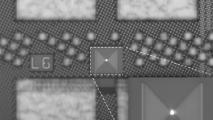Japanese researchers have developed a wearable that delivers a painless vibration to a person’s fingertip if it senses that they’re off balance — and they think it could help prevent falls among seniors.
Postural sway: As people age, their sense of balance tends to decline. That can result in an increase in “postural sway” — the movement of the torso and upper body forward and backward as a person stands upright.
This movement can increase a person’s risk of falling, and because falls are the leading cause of injury in people over the age 65, reducing postural sway in seniors also means reducing their chances of getting hurt.
The challenge: Walking aids, such as canes, can help reduce postural sway, but they can be difficult to use properly in situations such as walking on stairs or getting out of a car.
Postural sway can also be reduced by lightly touching an object with your fingertips. Even if this object is just a hanging curtain or piece of paper, which can’t provide any physical support, the feedback is enough to correct your balance.
This phenomenon is known as light touch, and it could help improve balance in seniors and reduce falls — but only if we can find a way to take advantage of it that doesn’t require a person to always walk around touching a wall or curtain.
The idea: Japanese researchers have now developed a wearable light touch system they believe will combat postural sway.
The device fits over the fingertip like a thimble, and the wearer holds their hand out in front of them (like they would if reaching out for a curtain). An acceleration sensor in the device monitors the wearer’s movement, sending data to a wrist-worn computer.
If the system senses postural sway, the device on the fingertip vibrates, with the intensity of the vibration matching the severity of the sway — this gives the wearer the sensation of coming in contact with a virtual curtain.
The system was tested on 150 people between the ages of 60 and 90, who were asked to use it with their eyes closed (which tends to increase postural sway). The result was a reduction in postural sway as significant as the one produced by traditional light touch with a hanging sheet of paper.
Looking ahead: The “virtual light touch” system has still only been trialed on healthy seniors who were standing still during the test — further trials are needed to see if it can help improve balance in those with increased postural sway while they’re walking.
If it can, the device could be a minimally invasive way to improve balance in seniors, helping prevent falls and reduce their risk of injury.
We’d love to hear from you! If you have a comment about this article or if you have a tip for a future Freethink story, please email us at tips@freethink.com.






